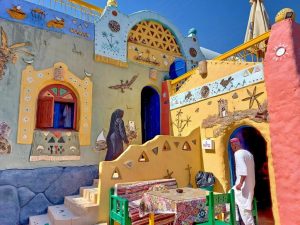Old Cairo, Masr al Qadima, lies within the old Roman fortress of Babylon, which was not only a walled but a heavily fortified city, with a narrow streets and cobbled alleys. How the name of the famous Babylon came to be echoed in Egypt is not unknown. The Coptic historian John, who lived at the time of Arab invasion, claimed that it is originally built during the Persian occupation of Egypt (525-332 B.C)
and that it was at that time called the fortress of Babylon. However, a much earlier visitor to the land of the Nile, the classical writer Diodorus, asserted that the name was brought y prisoners of war from great Babylon; the twelfth –dynasty pharaoh Senusert III, some two thousand years B.C, brought them to build public works. These Babylonians revolted against the Egyptians and built a fortification for protection, which had long fallen to ruin when the Persians came and repaired it.
When the Roman geographer Strabo came to Egypt in 24 B.C., he that Old Cairo was a fortress town and was occupied by three Roman garrisons. The emperor Trajan(98-117) cleared a canal that was running through the city and included some urban areas into the enlarged fortress. By this time the area was known as the Castle of Babylon. Under the Christian emperor Arcadius(395-408), the Copts began to build numerous churches in and around Old Cairo. At the time of the Arab conquest in 641, Babylon was such a sizable community that part of the fortress, including the huge towers and bastions, was connected y the walls to the newly founded Arab capital of Fustat. The towers and the bastions were at first used as dwellings for the garrison. Later Amr ibn al-Aas, a major leader of the Arabs at the time of the conquest, returned to the Copts land that the imperial government had taken from them. When Fustat took over the role of the capital from Alexandria, the whole of the Old Cairo was inhabited exclusively by Copts, and the Arabs recruited local labor from their ranks.










